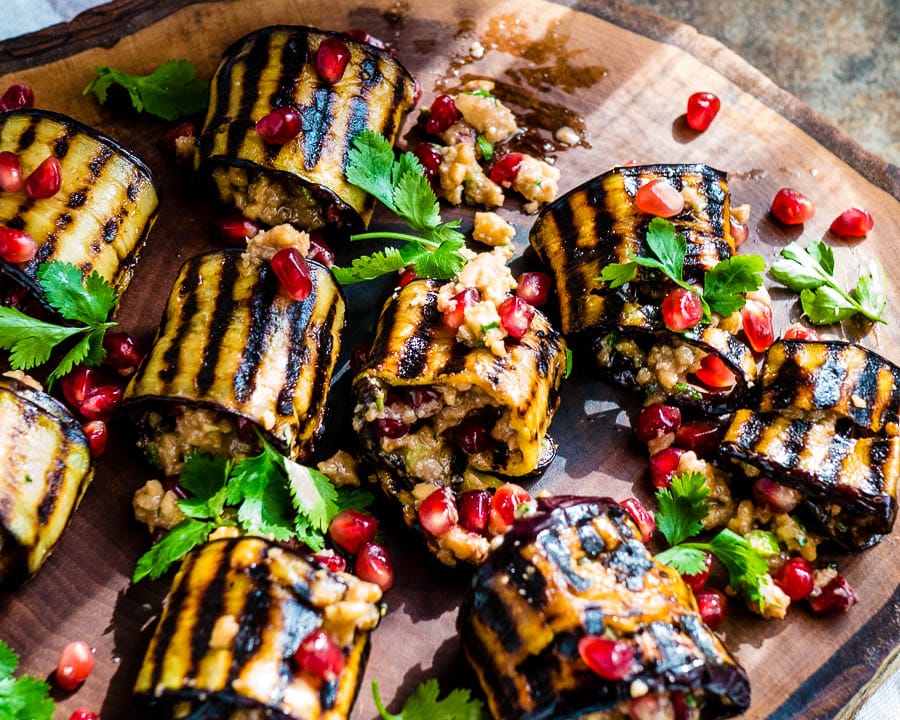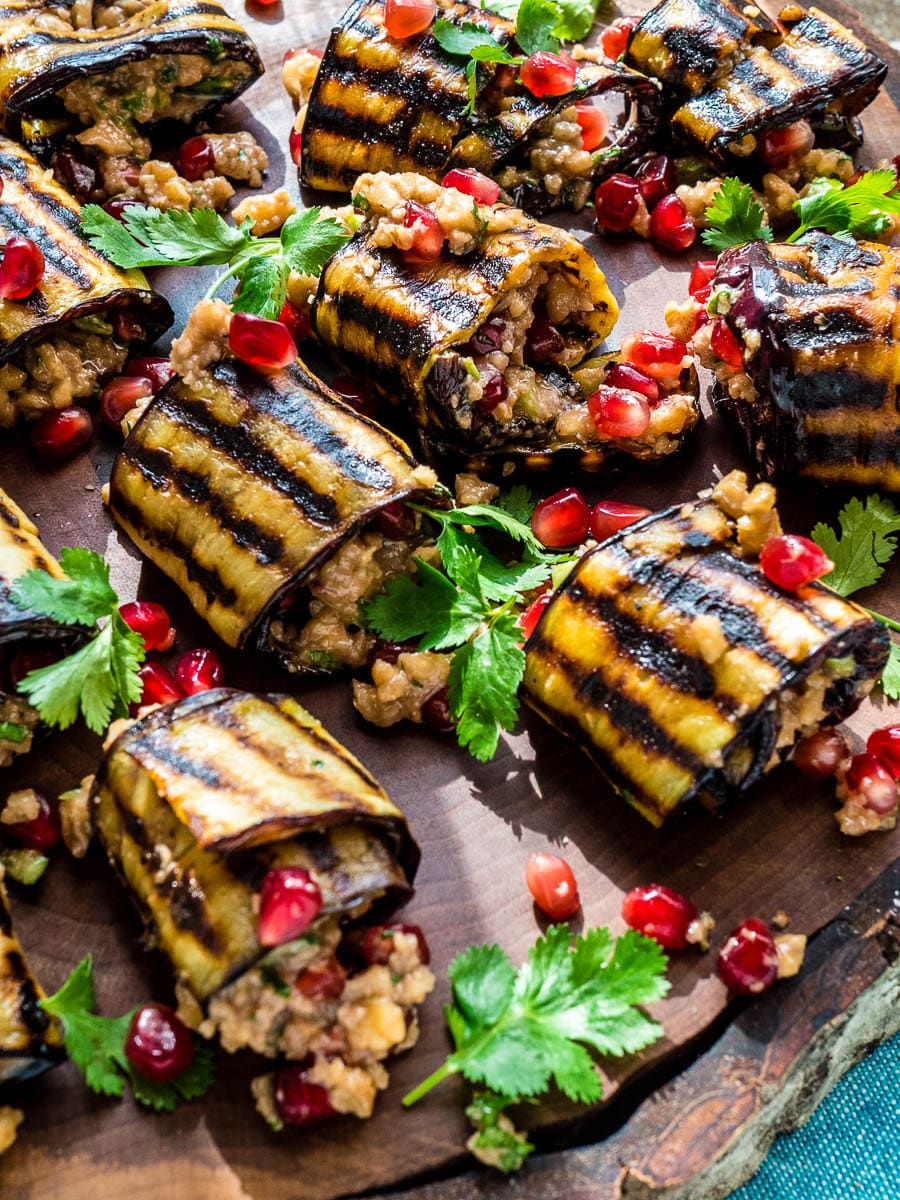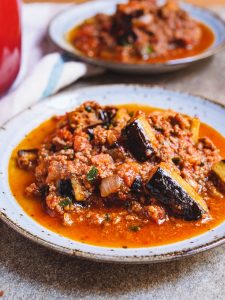Badrizhan nigzvit is one of the most famous and delectable dishes of Georgian cuisine. These naturally vegan Georgian aubergine rolls stuffed with a walnut paste are a breeze to make and taste as delicious as they look.
I haven’t yet had the chance to visit Georgia, but I’ve long been mesmerised by the flavours of their food culture.
Its links to neighbouring countries such as Iran and Turkey are evident. Dishes typical of the Black Sea, heavy with cheese and butter, mixes with more delicate ingredients typical of Iranian cooking, such as walnuts and pomegranate.
Georgians are in fact a significant minority in parts of Turkey, many of them young men coming here for work (though this has eased off in recent years as the Turkish currency has become less competitive).
Still, my first taste of Georgian food was in London, at the beautiful and unassuming restaurant Little Georgia near Broadway Market, my favourite weekend market. I’ll never forget that first bite of beautiful khinkali, dumplings filled with meat and onion similar to the dumplings found throughout Central Asia and in Turkey.
From that moment on, I was keen to explore more
Walnut stuffed Georgian aubergine rolls
These naturally vegan Georgian aubergine rolls are one of the most famous and beloved dishes of Georgian cuisine. It’s easy to understand why.
They’re a breeze to make and taste wonderful. And they look fantastic.
Though the core is the same, different versions of this dish exist all across Georgia. Indeed, a quick look at my cookbooks focusing on Georgian cuisine quickly reveals different approaches.

Georgian Cuisine, a 1959 Soviet collection of Georgian recipes by Tamara Sulakvelidze, has the simplest, suggesting to fill the aubergine slices with shelled walnuts mixed with fresh coriander as well as crushed chili pepper, wine vinegar or pomegranate juice, and salt.
The book also contains a number of other recipes aubergines and walnuts where the flavourings are more similar to the recipes for badrizhani nigzvit in modern-day cookbooks.
In Samarkand (affiliate link), Caroline Eden and Eleanor Ford make a freshly flavoured version, relying on large amounts of walnuts flavoured only by fresh coriander, pomegranate seeds, garlic, chili and lemon, drizzling with pomegranate molasses upon serving.
Tiko Tuskadze, founder of aforementioned Little Georgia and author of cookbook Supra (affiliate link), adds more complex flavours through typical spices in Georgian cuisine. Fresh ingredients are still aplenty, though spring onions, fresh coriander and parsley are joined by spices such as blue fenugreek, ground coriander, marigold and chili flakes.
Olia Hercules’ version in Kaukasis (affiliate link) is the most unique, relying on a local version from Zugdidi in Western Georgia. Here the walnuts are joined by plenty of sweet, golden onions as well as adjika – a spice mixture containing blue fenugreek, coriander, marigold petals, garlic cloves and cayenne pepper – and fresh herbs. Rather than rolling them up, Hercules bakes aubergine halves, which she then folds in half with the stuffing in the middle.
All these versions obviously have merits, and I recommend trying different versions. I own all of the above mentioned cookbooks and can only highly recommend each of them, though Georgian Cuisine may be a touch daunting to some (it’s an old cookbook with no pictures, plenty of recipes and limited instructions and information on amounts of each ingredient).
A few notes on this recipe
My version falls somewhere in between that found in Samarkand and Supra. Plenty of fresh ingredients, but with a touch of spices to bring out that uniquely Georgian flavour. Perfect for bringing out maximum flavour of a vegan dish.
Unfortunately, Georgian spices are hard to find. As such, I’ve made them with regular fenugreek rather than blue fenugreek, and sometimes omit it altogether. The aubergine rolls are delicious either way.

As for the aubergines, any variety can be used to make Georgian aubergine rolls. However, if you can find them, the long, straight and slender versions work best. The shape will make it easier to roll the aubergine slices up into beautiful rolls.
Originally, badrizhan nigzvit is a summer dish, made when aubergines are at their best at the peak of summer. However, the addition of fresh pomegranate seeds skews this picture somewhat.
In Istanbul, pomegranates aren’t available in summer, so I tend to make them in late summer/early autumn only. In most Western countries, this dish can be made year round.
Serving tips
Georgian aubergine rolls are great for making ahead. They’ll keep for a few days in the fridge. Just make sure to take them out early enough to come to room temperature before serving.
Cooked aubergines are better when not refrigerated before eating. If it suits your timetable you can also make the walnut filling ahead of time, but cook the aubergines and make the rolls on the day of serving. But making the whole dish ahead also works.

Badrizhan nigzvit is traditionally served as part of a supra, the Georgian meze/tapas table. That is, serve it alongside another few dishes designed for each person to have a bite or two. Here are a few suggestions which, although Turkish, go well with this Georgian classic:
That said, they are delicious as starters in their own right. Perhaps with a glass of rakı, ouzo or arak?
The recipe makes 12 aubergine rolls, enough for 4-6 servings, depending on what else you’re offering up.

Georgian aubergine rolls with walnuts (Badrizhan nigzvit)
Ingredients
- 3–4 aubergine (eggplant), preferably of the long, slender variety
- 3–4 Tbsp walnut oil, or olive oil, to brush the aubergine slices
- salt and pepper
Walnut filling
- ½ medium red onion, finely chopped
- 125 g shelled walnuts
- 1 green chili, finely chopped
- 10 g coriander (cilantro), finely chopped, plus extra to garnish
- 75 g pomegranate seeds, from c. ½ large pomegranate
- ½ tsp ground coriander
- ½ tsp ground fenugreek, or Georgian utskhosuneli, if you have it (optional)
- 2 garlic cloves, crushed to a paste
- 1 Tbsp white wine vinegar
- salt and pepper
How I make it
- Preheat the oven to
220 °C. Cover an oven tray with baking parchment.
- Mix the chopped red onion with a little salt. Set aside for half an hour.
- At the same time, top and tail the aubergines. Cut into ½ cm (⅕ in) slices lengthwise. It’s easiest to cut from the thickest part towards the thinner part. Discard the first and last slice (these are mostly skin). You need enough aubergine to make 12 slices.
- Place the aubergine slices on the baking parchment. Brush both sides with oil and season with salt and pepper. Bake in a hot oven until softened, 15-20 minutes. Leave to cool.
- Meanwhile, using a kitchen machine, whizz the walnuts to a paste. You’ll need to stop to scrape down the sides multiple times. The process will take a few minutes. Transfer to a bowl.
- Squeeze the liquids out of the red onion, then add to the walnut paste along with the remaining ingredients for the filling. Season to taste with salt and pepper.
- Place the aubergine slices with the most beautiful looking side down. Add a little filling at one end and roll up. Place on a serving tray with the joint facing down. If you like, you can also use a toothpick to hold it together. Repeat with the remaining aubergine slices. Just before serving, garnish with a few extra pomegranate seeds and whole coriander leaves.

















